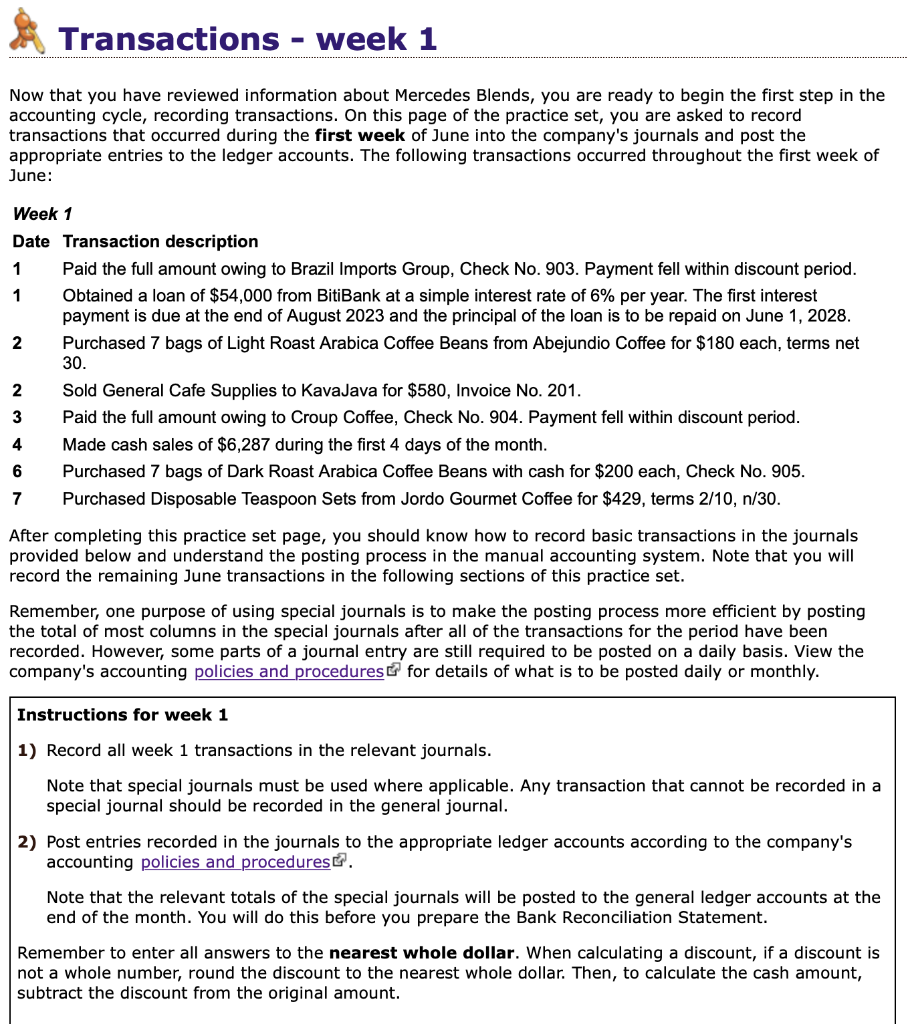
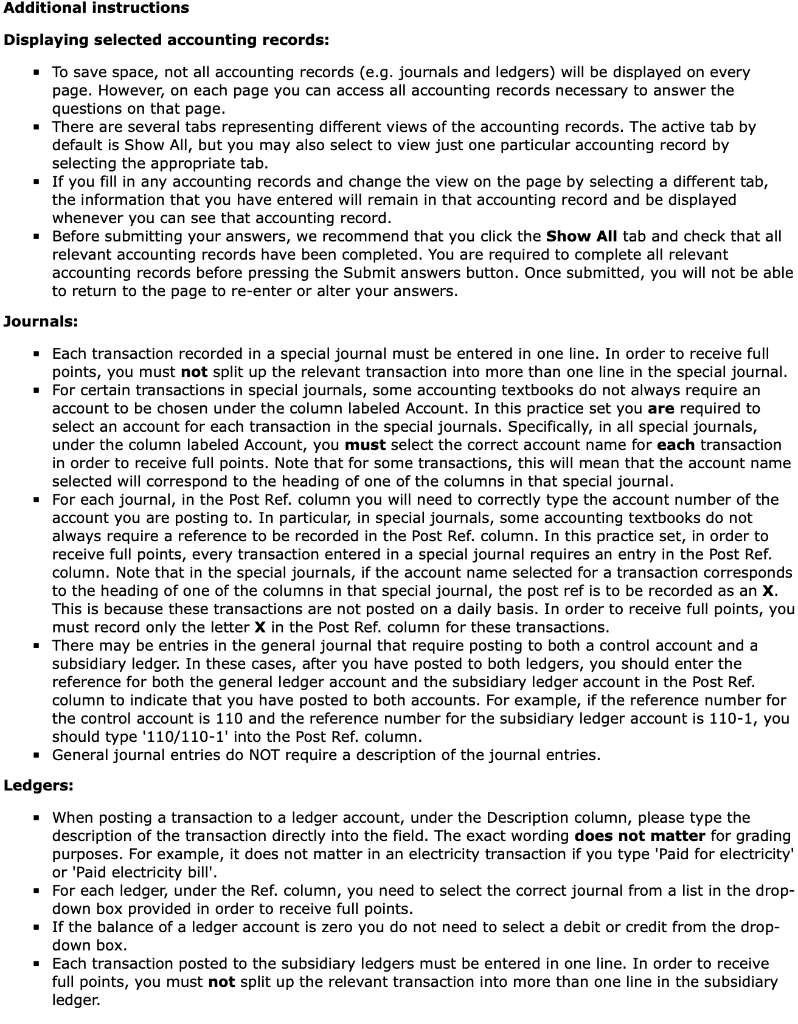

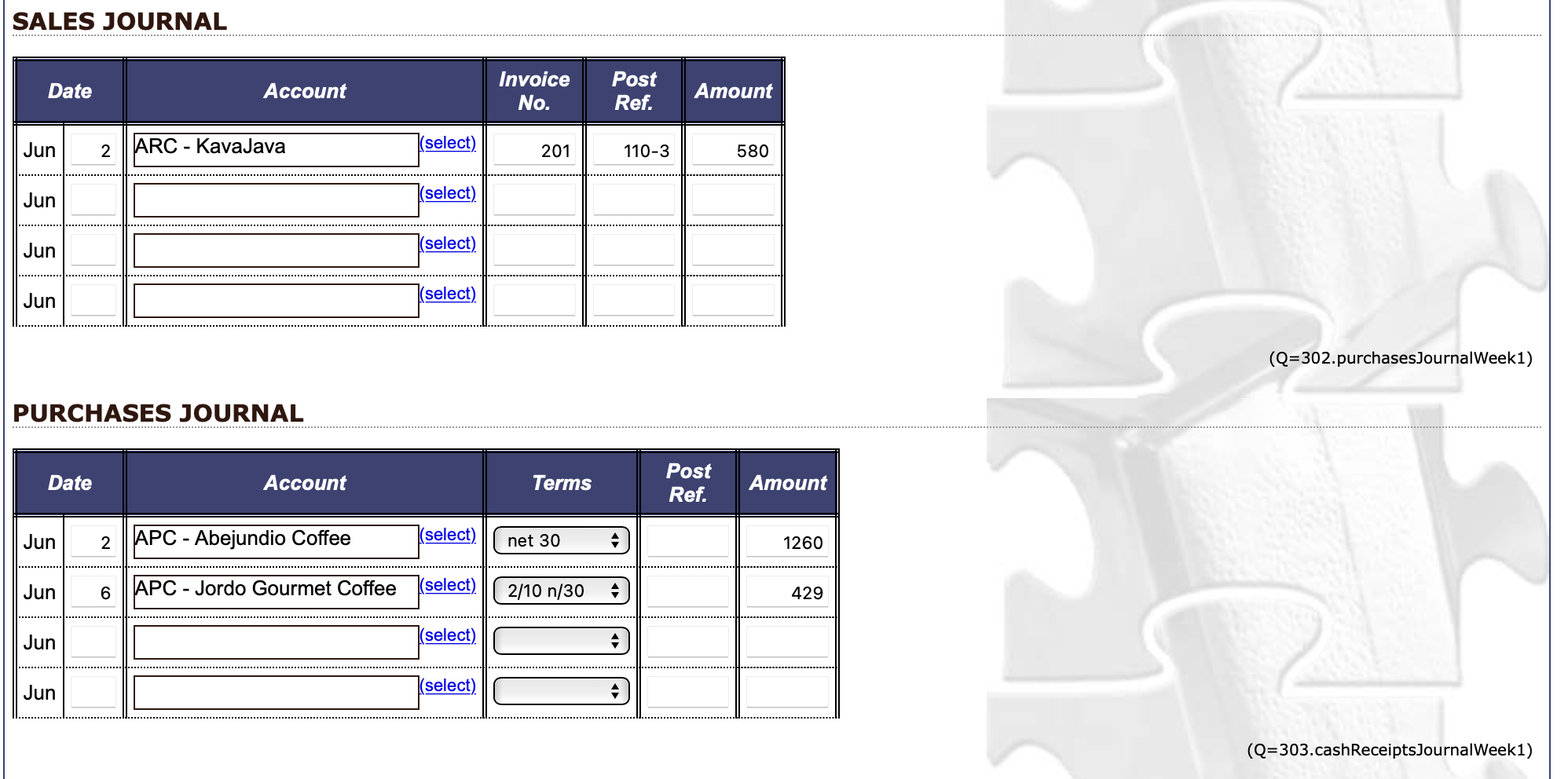
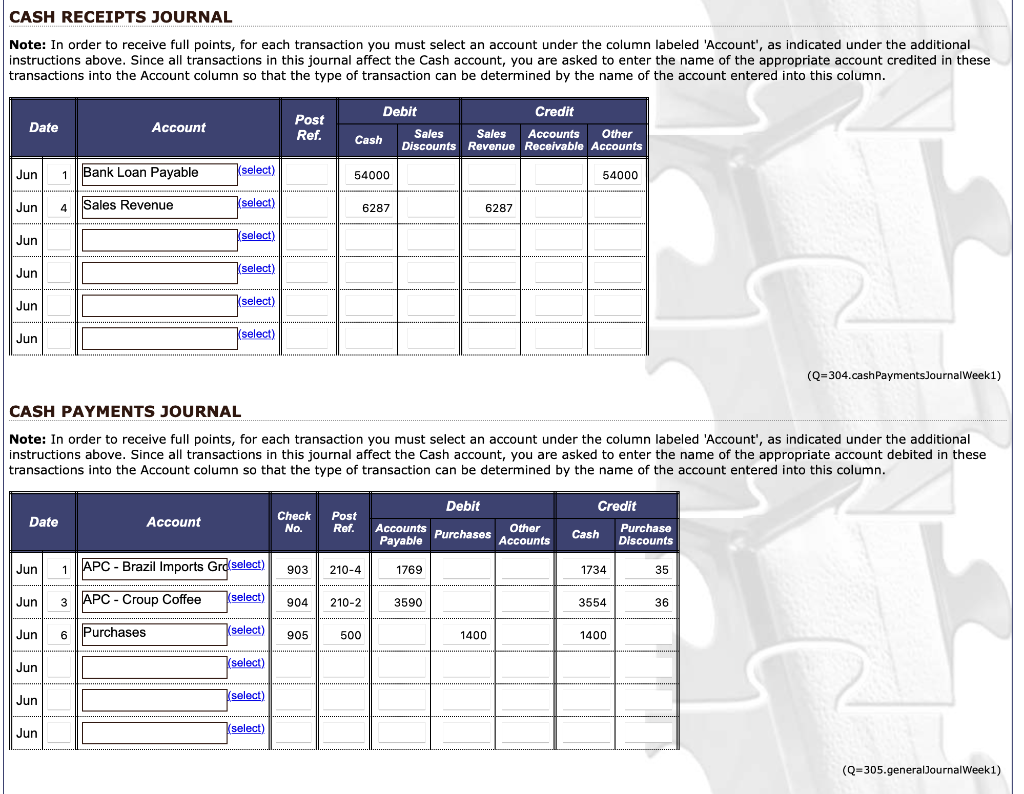
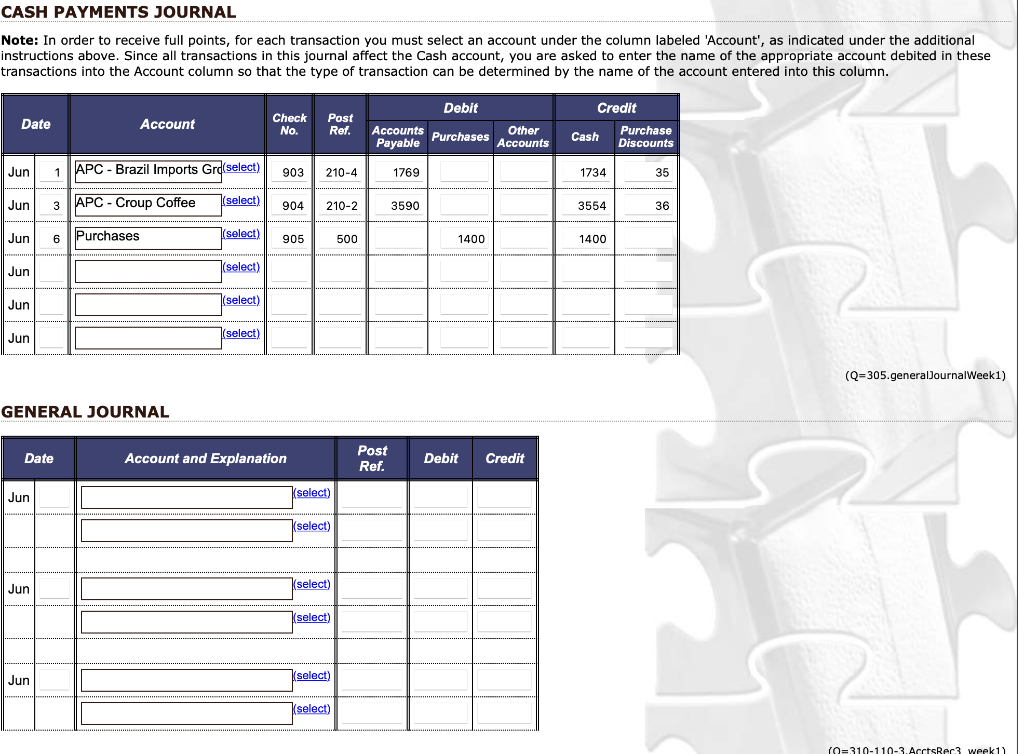
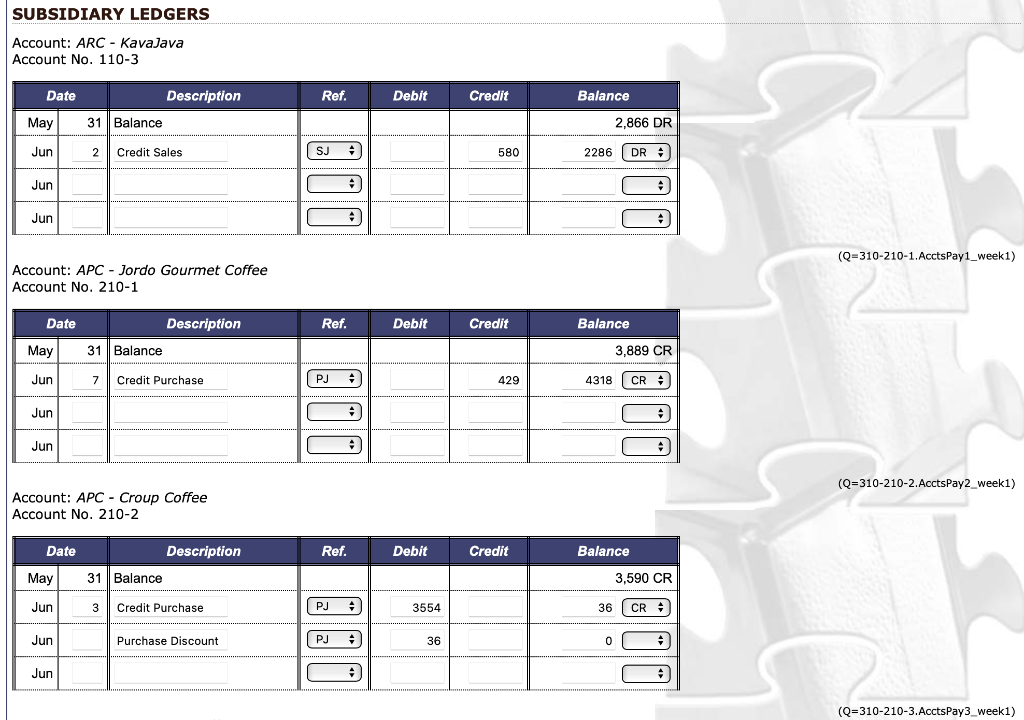

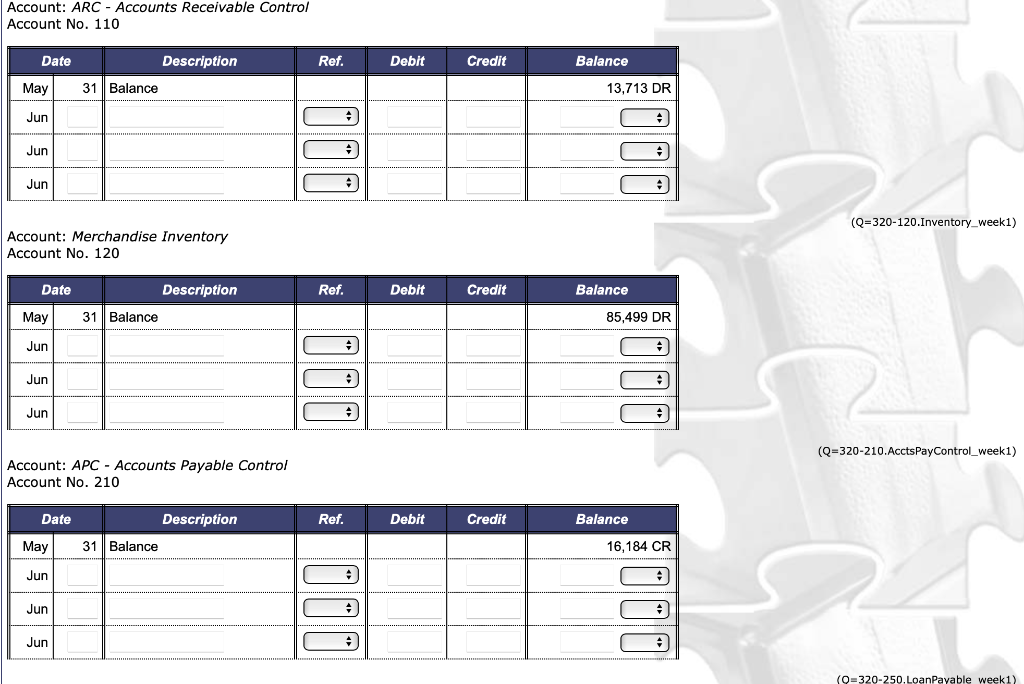
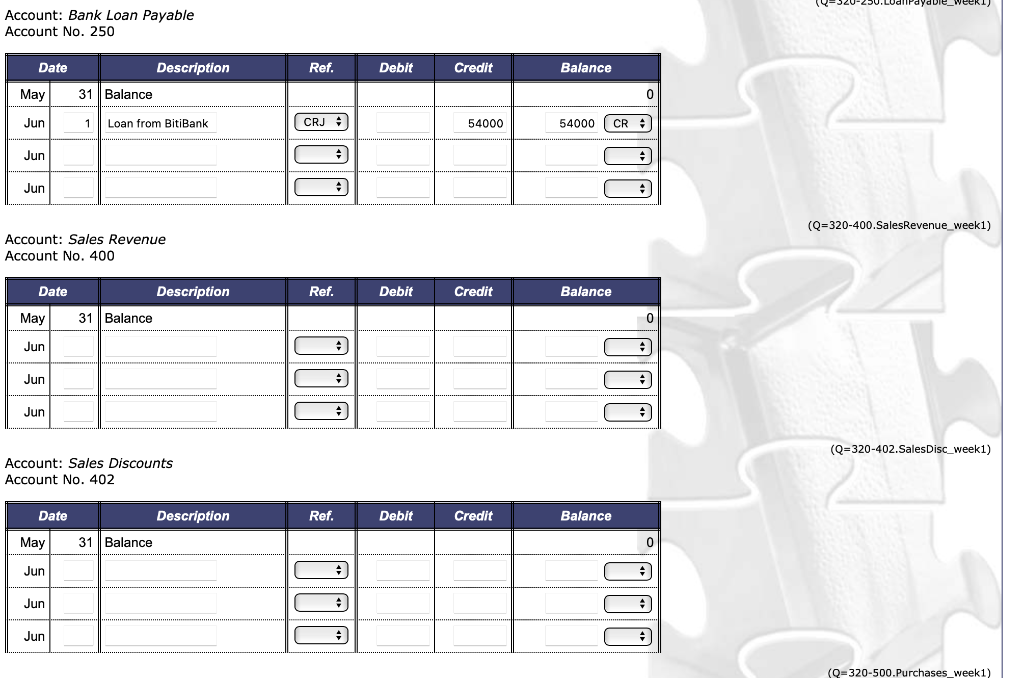
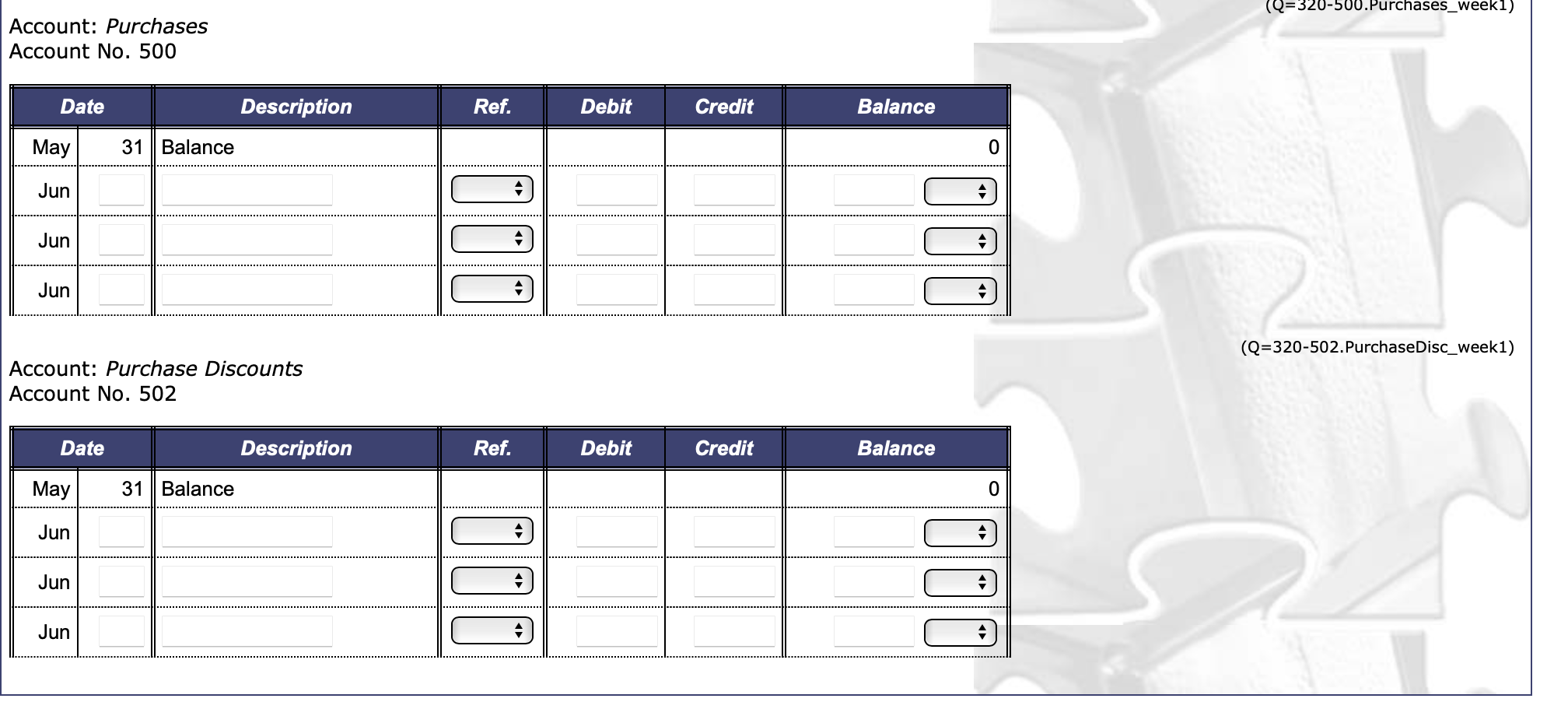
Now that you have reviewed information about Mercedes Blends, you are ready to begin the first step in the accounting cycle, recording transactions. On this page of the practice set, you are asked to record transactions that occurred during the first week of June into the company's journals and post the appropriate entries to the ledger accounts. The following transactions occurred throughout the first week of June: Week 1 Date Transaction description 1 Paid the full amount owing to Brazil Imports Group, Check No. 903. Payment fell within discount period. 1 Obtained a loan of $54,000 from BitiBank at a simple interest rate of 6% per year. The first interest payment is due at the end of August 2023 and the principal of the loan is to be repaid on June 1, 2028. 2 Purchased 7 bags of Light Roast Arabica Coffee Beans from Abejundio Coffee for $180 each, terms net 30. 2 Sold General Cafe Supplies to KavaJava for \$580, Invoice No. 201. 3 Paid the full amount owing to Croup Coffee, Check No. 904. Payment fell within discount period. 4 Made cash sales of $6,287 during the first 4 days of the month. 6 Purchased 7 bags of Dark Roast Arabica Coffee Beans with cash for $200 each, Check No. 905. 7 Purchased Disposable Teaspoon Sets from Jordo Gourmet Coffee for $429, terms 2/10, n/30. After completing this practice set page, you should know how to record basic transactions in the journals provided below and understand the posting process in the manual accounting system. Note that you will record the remaining June transactions in the following sections of this practice set. Remember, one purpose of using special journals is to make the posting process more efficient by posting the total of most columns in the special journals after all of the transactions for the period have been recorded. However, some parts of a journal entry are still required to be posted on a daily basis. View the company's accounting policies and procedures for details of what is to be posted daily or monthly. Instructions for week 1 1) Record all week 1 transactions in the relevant journals. Note that special journals must be used where applicable. Any transaction that cannot be recorded in a special journal should be recorded in the general journal. 2) Post entries recorded in the journals to the appropriate ledger accounts according to the company's accounting policies and procedures Note that the relevant totals of the special journals will be posted to the general ledger accounts at the end of the month. You will do this before you prepare the Bank Reconciliation Statement. Remember to enter all answers to the nearest whole dollar. When calculating a discount, if a discount is not a whole number, round the discount to the nearest whole dollar. Then, to calculate the cash amount, subtract the discount from the original amount. Additional instructions Displaying selected accounting records: - To save space, not all accounting records (e.g. journals and ledgers) will be displayed on every page. However, on each page you can access all accounting records necessary to answer the questions on that page. - There are several tabs representing different views of the accounting records. The active tab by default is Show All, but you may also select to view just one particular accounting record by selecting the appropriate tab. - If you fill in any accounting records and change the view on the page by selecting a different tab, the information that you have entered will remain in that accounting record and be displayed whenever you can see that accounting record. - Before submitting your answers, we recommend that you click the Show All tab and check that all relevant accounting records have been completed. You are required to complete all relevant accounting records before pressing the Submit answers button. Once submitted, you will not be able to return to the page to re-enter or alter your answers. Journals: - Each transaction recorded in a special journal must be entered in one line. In order to receive full points, you must not split up the relevant transaction into more than one line in the special journal. - For certain transactions in special journals, some accounting textbooks do not always require an account to be chosen under the column labeled Account. In this practice set you are required to select an account for each transaction in the special journals. Specifically, in all special journals, under the column labeled Account, you must select the correct account name for each transaction in order to receive full points. Note that for some transactions, this will mean that the account name selected will correspond to the heading of one of the columns in that special journal. - For each journal, in the Post Ref. column you will need to correctly type the account number of the account you are posting to. In particular, in special journals, some accounting textbooks do not always require a reference to be recorded in the Post Ref. column. In this practice set, in order to receive full points, every transaction entered in a special journal requires an entry in the Post Ref. column. Note that in the special journals, if the account name selected for a transaction corresponds to the heading of one of the columns in that special journal, the post ref is to be recorded as an X. This is because these transactions are not posted on a daily basis. In order to receive full points, you must record only the letter X in the Post Ref. column for these transactions. - There may be entries in the general journal that require posting to both a control account and a subsidiary ledger. In these cases, after you have posted to both ledgers, you should enter the reference for both the general ledger account and the subsidiary ledger account in the Post Ref. column to indicate that you have posted to both accounts. For example, if the reference number for the control account is 110 and the reference number for the subsidiary ledger account is 1101, you should type '110/110-1' into the Post Ref. column. - General journal entries do NOT require a description of the journal entries. Ledgers: - When posting a transaction to a ledger account, under the Description column, please type the description of the transaction directly into the field. The exact wording does not matter for grading purposes. For example, it does not matter in an electricity transaction if you type 'Paid for electricity' or 'Paid electricity bill'. - For each ledger, under the Ref. column, you need to select the correct journal from a list in the dropdown box provided in order to receive full points. - If the balance of a ledger account is zero you do not need to select a debit or credit from the dropdown box. - Each transaction posted to the subsidiary ledgers must be entered in one line. In order to receive full points, you must not split up the relevant transaction into more than one line in the subsidiary ledger. - When posting a transaction to a ledger account, under the Description column, please type the description of the transaction directly into the field. The exact wording does not matter for grading purposes. For example, it does not matter in an electricity transaction if you type 'Paid for electricity' or 'Paid electricity bill'. - For each ledger, under the Ref. column, you need to select the correct journal from a list in the dropdown box provided in order to receive full points. - If the balance of a ledger account is zero you do not need to select a debit or credit from the dropdown box. - Each transaction posted to the subsidiary ledgers must be entered in one line. In order to receive full points, you must not split up the relevant transaction into more than one line in the subsidiary ledger. oth journals and ledgers: - Most journals and ledgers will have blank rows left at the end of the page. - Some journals and ledgers may not require any entries. (Q=302.purchasesJournalWeek1) PURCHASES JOURNAL Note: In order to receive full points, for each transaction you must select an account under the column labeled 'Account', as indicated under the additional instructions above. Since all transactions in this journal affect the Cash account, you are asked to enter the name of the appropriate account credited in these transactions into the Account column so that the type of transaction can be determined by the name of the account entered into this column. (Q=304.cashPaymentsJournalWeek1) CASH PAYMENTS JOURNAL Note: In order to receive full points, for each transaction you must select an account under the column labeled 'Account', as indicated under the additional instructions above. Since all transactions in this journal affect the Cash account, you are asked to enter the name of the appropriate account debited in these transactions into the Account column so that the type of transaction can be determined by the name of the account entered into this column. (Q=305.generalJournalWeek1) Note: In order to receive full points, for each transaction you must select an account under the column labeled 'Account', as indicated under the additional instructions above. Since all transactions in this journal affect the Cash account, you are asked to enter the name of the appropriate account debited in these transactions into the Account column so that the type of transaction can be determined by the name of the account entered into this column. (Q=305.generalJournalWeek1) GENERAL JOURNAL SUBSIDIARY LEDGERS Account: ARC - KavaJava Account No. 110-3 (Q=3102101.AcctsPay1_week1) Account: APC - Jordo Gourmet Coffee Account No. 210-1 (Q=3102102.AcctsPay2_week1) Account: APC - Croup Coffee Account No. 2102 Account: APC - Abejundio Coffee Account No. 210-3 (Q=3102104.AcctsPay4_week1) Account: APC - Brazil Imports Group Account No. 210-4 (Q=320100.Cash_week1) GENERAL LEDGER Account: Cash Account No. 100 Account: ARC - Accounts Receivable Control Account No. 110 Account: ARC - Accounts Receivable Control Account No. 110 (Q=320120.Inventory_week1) Account: Merchandise Inventory Account No. 120 (Q=320210.AcctsPayControl_week1) Account: APC - Accounts Payable Control Account No. 210 Account: Bank Loan Payable Account No. 250 (Q=320400. SalesRevenue_week1) Account: Sales Revenue Account No. 400 (Q=320402.SalesDisc_week1) Account: Sales Discounts Account No. 402 Account: Purchases Account No. 500 (Q=320502.PurchaseDisc_week 1 ) Account: Purchase Discounts Account No. 502 Now that you have reviewed information about Mercedes Blends, you are ready to begin the first step in the accounting cycle, recording transactions. On this page of the practice set, you are asked to record transactions that occurred during the first week of June into the company's journals and post the appropriate entries to the ledger accounts. The following transactions occurred throughout the first week of June: Week 1 Date Transaction description 1 Paid the full amount owing to Brazil Imports Group, Check No. 903. Payment fell within discount period. 1 Obtained a loan of $54,000 from BitiBank at a simple interest rate of 6% per year. The first interest payment is due at the end of August 2023 and the principal of the loan is to be repaid on June 1, 2028. 2 Purchased 7 bags of Light Roast Arabica Coffee Beans from Abejundio Coffee for $180 each, terms net 30. 2 Sold General Cafe Supplies to KavaJava for \$580, Invoice No. 201. 3 Paid the full amount owing to Croup Coffee, Check No. 904. Payment fell within discount period. 4 Made cash sales of $6,287 during the first 4 days of the month. 6 Purchased 7 bags of Dark Roast Arabica Coffee Beans with cash for $200 each, Check No. 905. 7 Purchased Disposable Teaspoon Sets from Jordo Gourmet Coffee for $429, terms 2/10, n/30. After completing this practice set page, you should know how to record basic transactions in the journals provided below and understand the posting process in the manual accounting system. Note that you will record the remaining June transactions in the following sections of this practice set. Remember, one purpose of using special journals is to make the posting process more efficient by posting the total of most columns in the special journals after all of the transactions for the period have been recorded. However, some parts of a journal entry are still required to be posted on a daily basis. View the company's accounting policies and procedures for details of what is to be posted daily or monthly. Instructions for week 1 1) Record all week 1 transactions in the relevant journals. Note that special journals must be used where applicable. Any transaction that cannot be recorded in a special journal should be recorded in the general journal. 2) Post entries recorded in the journals to the appropriate ledger accounts according to the company's accounting policies and procedures Note that the relevant totals of the special journals will be posted to the general ledger accounts at the end of the month. You will do this before you prepare the Bank Reconciliation Statement. Remember to enter all answers to the nearest whole dollar. When calculating a discount, if a discount is not a whole number, round the discount to the nearest whole dollar. Then, to calculate the cash amount, subtract the discount from the original amount. Additional instructions Displaying selected accounting records: - To save space, not all accounting records (e.g. journals and ledgers) will be displayed on every page. However, on each page you can access all accounting records necessary to answer the questions on that page. - There are several tabs representing different views of the accounting records. The active tab by default is Show All, but you may also select to view just one particular accounting record by selecting the appropriate tab. - If you fill in any accounting records and change the view on the page by selecting a different tab, the information that you have entered will remain in that accounting record and be displayed whenever you can see that accounting record. - Before submitting your answers, we recommend that you click the Show All tab and check that all relevant accounting records have been completed. You are required to complete all relevant accounting records before pressing the Submit answers button. Once submitted, you will not be able to return to the page to re-enter or alter your answers. Journals: - Each transaction recorded in a special journal must be entered in one line. In order to receive full points, you must not split up the relevant transaction into more than one line in the special journal. - For certain transactions in special journals, some accounting textbooks do not always require an account to be chosen under the column labeled Account. In this practice set you are required to select an account for each transaction in the special journals. Specifically, in all special journals, under the column labeled Account, you must select the correct account name for each transaction in order to receive full points. Note that for some transactions, this will mean that the account name selected will correspond to the heading of one of the columns in that special journal. - For each journal, in the Post Ref. column you will need to correctly type the account number of the account you are posting to. In particular, in special journals, some accounting textbooks do not always require a reference to be recorded in the Post Ref. column. In this practice set, in order to receive full points, every transaction entered in a special journal requires an entry in the Post Ref. column. Note that in the special journals, if the account name selected for a transaction corresponds to the heading of one of the columns in that special journal, the post ref is to be recorded as an X. This is because these transactions are not posted on a daily basis. In order to receive full points, you must record only the letter X in the Post Ref. column for these transactions. - There may be entries in the general journal that require posting to both a control account and a subsidiary ledger. In these cases, after you have posted to both ledgers, you should enter the reference for both the general ledger account and the subsidiary ledger account in the Post Ref. column to indicate that you have posted to both accounts. For example, if the reference number for the control account is 110 and the reference number for the subsidiary ledger account is 1101, you should type '110/110-1' into the Post Ref. column. - General journal entries do NOT require a description of the journal entries. Ledgers: - When posting a transaction to a ledger account, under the Description column, please type the description of the transaction directly into the field. The exact wording does not matter for grading purposes. For example, it does not matter in an electricity transaction if you type 'Paid for electricity' or 'Paid electricity bill'. - For each ledger, under the Ref. column, you need to select the correct journal from a list in the dropdown box provided in order to receive full points. - If the balance of a ledger account is zero you do not need to select a debit or credit from the dropdown box. - Each transaction posted to the subsidiary ledgers must be entered in one line. In order to receive full points, you must not split up the relevant transaction into more than one line in the subsidiary ledger. - When posting a transaction to a ledger account, under the Description column, please type the description of the transaction directly into the field. The exact wording does not matter for grading purposes. For example, it does not matter in an electricity transaction if you type 'Paid for electricity' or 'Paid electricity bill'. - For each ledger, under the Ref. column, you need to select the correct journal from a list in the dropdown box provided in order to receive full points. - If the balance of a ledger account is zero you do not need to select a debit or credit from the dropdown box. - Each transaction posted to the subsidiary ledgers must be entered in one line. In order to receive full points, you must not split up the relevant transaction into more than one line in the subsidiary ledger. oth journals and ledgers: - Most journals and ledgers will have blank rows left at the end of the page. - Some journals and ledgers may not require any entries. (Q=302.purchasesJournalWeek1) PURCHASES JOURNAL Note: In order to receive full points, for each transaction you must select an account under the column labeled 'Account', as indicated under the additional instructions above. Since all transactions in this journal affect the Cash account, you are asked to enter the name of the appropriate account credited in these transactions into the Account column so that the type of transaction can be determined by the name of the account entered into this column. (Q=304.cashPaymentsJournalWeek1) CASH PAYMENTS JOURNAL Note: In order to receive full points, for each transaction you must select an account under the column labeled 'Account', as indicated under the additional instructions above. Since all transactions in this journal affect the Cash account, you are asked to enter the name of the appropriate account debited in these transactions into the Account column so that the type of transaction can be determined by the name of the account entered into this column. (Q=305.generalJournalWeek1) Note: In order to receive full points, for each transaction you must select an account under the column labeled 'Account', as indicated under the additional instructions above. Since all transactions in this journal affect the Cash account, you are asked to enter the name of the appropriate account debited in these transactions into the Account column so that the type of transaction can be determined by the name of the account entered into this column. (Q=305.generalJournalWeek1) GENERAL JOURNAL SUBSIDIARY LEDGERS Account: ARC - KavaJava Account No. 110-3 (Q=3102101.AcctsPay1_week1) Account: APC - Jordo Gourmet Coffee Account No. 210-1 (Q=3102102.AcctsPay2_week1) Account: APC - Croup Coffee Account No. 2102 Account: APC - Abejundio Coffee Account No. 210-3 (Q=3102104.AcctsPay4_week1) Account: APC - Brazil Imports Group Account No. 210-4 (Q=320100.Cash_week1) GENERAL LEDGER Account: Cash Account No. 100 Account: ARC - Accounts Receivable Control Account No. 110 Account: ARC - Accounts Receivable Control Account No. 110 (Q=320120.Inventory_week1) Account: Merchandise Inventory Account No. 120 (Q=320210.AcctsPayControl_week1) Account: APC - Accounts Payable Control Account No. 210 Account: Bank Loan Payable Account No. 250 (Q=320400. SalesRevenue_week1) Account: Sales Revenue Account No. 400 (Q=320402.SalesDisc_week1) Account: Sales Discounts Account No. 402 Account: Purchases Account No. 500 (Q=320502.PurchaseDisc_week 1 ) Account: Purchase Discounts Account No. 502

















